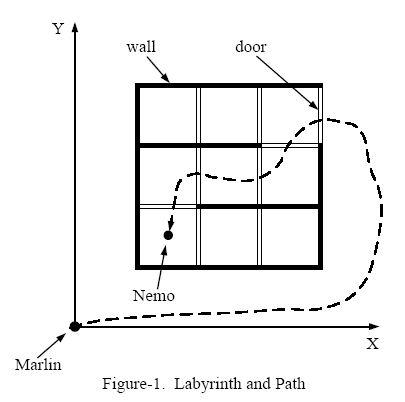POJ-2049 Finding Nemo(BFS)¶
Description¶
Nemo is a naughty boy. One day he went into the deep sea all by himself. Unfortunately, he became lost and couldn't find his way home. Therefore, he sent a signal to his father, Marlin, to ask for help. After checking the map, Marlin found that the sea is like a labyrinth with walls and doors. All the walls are parallel to the X-axis or to the Y-axis. The thickness of the walls are assumed to be zero. All the doors are opened on the walls and have a length of 1. Marlin cannot go through a wall unless there is a door on the wall. Because going through a door is dangerous (there may be some virulent medusas near the doors), Marlin wants to go through as few doors as he could to find Nemo. Figure-1 shows an example of the labyrinth and the path Marlin went through to find Nemo.

We assume Marlin's initial position is at (0, 0). Given the position of Nemo and the configuration of walls and doors, please write a program to calculate the minimum number of doors Marlin has to go through in order to reach Nemo.
Input¶
The input consists of several test cases. Each test case is started by two non-negative integers M and N. M represents the number of walls in the labyrinth and N represents the number of doors. Then follow M lines, each containing four integers that describe a wall in the following format: x y d t (x, y) indicates the lower-left point of the wall, d is the direction of the wall -- 0 means it's parallel to the X-axis and 1 means that it's parallel to the Y-axis, and t gives the length of the wall. The coordinates of two ends of any wall will be in the range of [1,199]. Then there are N lines that give the description of the doors: x y d x, y, d have the same meaning as the walls. As the doors have fixed length of 1, t is omitted. The last line of each case contains two positive float numbers: f1 f2 (f1, f2) gives the position of Nemo. And it will not lie within any wall or door. A test case of M = -1 and N = -1 indicates the end of input, and should not be processed.
Output¶
For each test case, in a separate line, please output the minimum number of doors Marlin has to go through in order to rescue his son. If he can't reach Nemo, output -1.
Sample Input¶
8 9
1 1 1 3
2 1 1 3
3 1 1 3
4 1 1 3
1 1 0 3
1 2 0 3
1 3 0 3
1 4 0 3
2 1 1
2 2 1
2 3 1
3 1 1
3 2 1
3 3 1
1 2 0
3 3 0
4 3 1
1.5 1.5
4 0
1 1 0 1
1 1 1 1
2 1 1 1
1 2 0 1
1.5 1.7
-1 -1
Sample Output¶
5
-1
#include <stdio.h>
#include <stdlib.h>
#include <string.h>
#define Max 210
#define Inf 10000010 //无穷大
int dir[4][2]={{1,0},{-1,0},{0,-1},{0,1}}; //四个搜索方向,上、下、左、右
int tran_top[Max][Max];
int tran_low[Max][Max];
int tran_left[Max][Max];
int tran_right[Max][Max];
int pos[Max][Max][2];
bool flag[Max][Max]; //记录格点是否搜索
int lowx,lowy,topx,topy; // 迷宫坐下点(lowx,lowy) 右下点(topx,topy)
int tx,ty; //转化后的终点坐标
int Sum; //最终结果
int n,m;
int h,w; //转化后的方格规格
int get_tran(int x,int y,int index){ // 得到从点(x,y)分别向上、下、左、右方向时遇到的是wall、door还是空
if(index==0)
return tran_top[x][y];
else if(index==1)
return tran_low[x][y];
else if(index==2)
return tran_left[x][y];
else
return tran_right[x][y];
}
void dfs(int x,int y,int num){ // dfs搜索最小值
if(num>=Sum) // 剪枝,若大于最小值,则直接返回
return ;
if(x==1 || x==h || y==1 || y==w){ //终点判定,若能到达迷宫外,说明可以找到,逆向搜索
Sum=num;
return ;
}
for(int i=0;i<4;i++){ //分别搜索四个方向
int tempx=x+dir[i][0],tempy=y+dir[i][1];
if(get_tran(x,y,i)==0 && !flag[tempx][tempy]){ //若为door,并且下一步方格没有搜索,则往该方向继续搜索
flag[tempx][tempy]=true;//设置为已经搜索
dfs(tempx,tempy,num+1);//继续深搜
flag[tempx][tempy]=false;//回溯
}
else if(get_tran(x,y,i)==-1 && !flag[tempx][tempy]){//若为空,则同上
flag[tempx][tempy]=true;
dfs(tempx,tempy,num);
flag[tempx][tempy]=false;
}
}
}
int main(){
while(scanf("%d%d",&n,&m),n!=-1){
int i,j,tex,tey,ted,tet;
memset(pos,-1,sizeof(pos)); //初始化为-1
lowx=lowy=Inf; // 初始化左下点坐标,右上点坐标
topx=topy=-1;
for(i=1;i<=n;i++){
scanf("%d%d%d%d",&tex,&tey,&ted,&tet);
if(tex<lowx) lowx=tex; //求左下角坐标
if(tey<lowy) lowy=tey;
if(!ted){
if(tex+tet>topx) topx=tex+tet; //右上点坐标
if(tey>topy) topy=tey;
for(j=tex;j<tex+tet;j++) // 设置横向pos
pos[j][tey][0]=1;
}
else{
if(tex>topx) topx=tex;
if(tey+tet>topy) topy=tey+tet;
for(j=tey;j<tey+tet;j++) //设置纵向pos
pos[tex][j][1]=1;
}
}
for(i=1;i<=m;i++){
scanf("%d%d%d",&tex,&tey,&ted);
if(tex<lowx) lowx=tex;
if(tey<lowy) lowy=tey;
if(!ted){
if(tex+1>topx) topx=tex+1;
if(tey>topy) topy=tey;
pos[tex][tey][0]=0; //设置横向pos
}
else{
if(tex>topx) topx=tex;
if(tey+1>topy) topy=tey+1;
pos[tex][tey][1]=0; // 设置纵向pos
}
}
int ix,iy;
for(i=lowy;i<topy;i++){ //利用pos将迷宫转化为熟悉的二维方格
ix=i-lowy+1;
for(j=lowx;j<topx;j++){
iy=j-lowx+2;
tran_top[ix][iy]=tran_low[ix+1][iy]=pos[j][i][0];
tran_right[ix+1][iy-1]=tran_left[ix+1][iy]=pos[j][i][1];
}
}
h=topy-lowy+2,w=topx-lowx+2; //方格规模
for(i=lowx;i<topx;i++) // 单独转化特殊情况pos
tran_top[h-1][i-lowx+2]=tran_low[h][i-lowx+2]=pos[i][topy][0];//=trans[h][i-lowx+2][h-1][i-lowx+2]=pos[i][topy][0];
for(i=lowy;i<topy;i++)// 单独转化特殊情况pos
tran_right[i-lowy+2][w-1]=tran_left[i-lowy+2][w]=pos[topx][i][1];//=trans[i-lowy+2][w][i-lowy+2][w-1]=pos[topx][i][1];
float tempx,tempy;
scanf("%f%f",&tempx,&tempy);
if(tempx<=lowx || tempx>=topx || tempy<=lowy || tempy>=topy){ //判断点是否在迷宫内
printf("0\n");
continue;
}
tx=int(tempy-lowy)+2;
ty=int(tempx-lowx)+2;
memset(flag,0,sizeof(flag));
flag[tx][ty]=1;
Sum=Inf;
dfs(tx,ty,0);
if(Sum==Inf) //若达不到终点
printf("-1\n");//输出-1
else //否则输出最小值
printf("%d\n",Sum);
}
return 0;
}
给定一个迷宫,给定迷宫的状态,即迷宫的每条单位边可能是wall,也可能是door,也可能是空。这些状态以点加方向加长度的形式给出。并给定搜索的起点和终点。要求出从起点到终点所必须经过的最少door数量。简单的搜索题。
主要是题目中迷宫的状态转化为常规的二维矩阵比较伤脑筋,也比较麻烦,其余的都好解决。
这里转化思路如下:
边分为横向和纵向两种方向,分别用0和1表示。可以事先创建一个三维矩阵pos[i][j][0]表示坐标(i,j)点横向一个单位的迷宫状态,用pos[i][j][1]表示坐标(i,j)点纵向一个单位的迷宫状态。用-1、0、1分别表示是空、door和wall。由于输入中只是输入door和wall的情况,所以可以事先将pos数字设为-1即均为空状态。然后根据输入依次填充pos数组。同时在输入的过程中将迷宫左下点(lowx,lowy)和右上点(topx,topy)的坐标求出来(通过比较,这个容易实现)。接着就进入转化了。转化过程如下:
事先设置四个二维数组,分别为tran_left、tran_right、tran_top、tran_low。设h=topy-lowy+2,w=topx-lowx。转化后的方格为h*w规格(不难想象)。用tran_left数组表示相邻点从左边一个方格到右边一个方格中间的边是wall、door、还是空。依次类推:right、top、low分别表示从右边到左边、从下到上、从上到下中间的边是wall、door、还是空。这个转化通过pos数组进行(不难实现),转化结束。
这里要注意几个问题:
1)由于终点可能并不再迷宫内,故要实现判定终点是否在迷宫内部,如果不再则输出0,否则根据转化后的矩阵dfs或bfs搜索最少值即可
2)根据dfs或bfs搜索最小值,若无法到大终点,则要输出-1,否则输出最小值
3)转化后的矩阵搜索起点应该在终点比较合适(已判定在迷宫内)